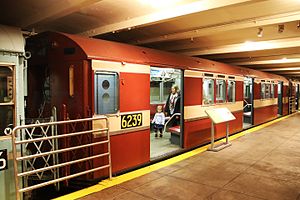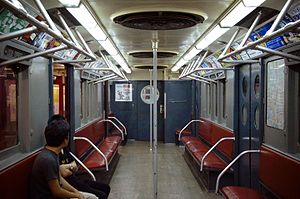
The 7 Flushing Local and <7> Flushing Express are two rapid transit services in the A Division of the New York City Subway, providing local and express services along the full length of the IRT Flushing Line. Their route emblems, or "bullets", are colored purple, since they serve the Flushing Line.

The R62 is a New York City Subway car model built between 1983 and 1985 by Kawasaki Heavy Industries in Kobe, Japan, for the A Division. A total of 325 cars were built, originally as single units. When the reliability of the fleet improved, they were converted to five-car sets. The cars replaced the remaining R12s, R14s, and R15s, which were all retired by the end of 1984.

The New York City Subway is a large rapid transit system and has a large fleet of electric multiple unit rolling stock. As of November 2016, the New York City Subway has 6418 cars on the roster.

Redbird trains were eight New York City Subway train models so-nicknamed because of their red paint. The Redbirds totaled 1,410 cars of the following types on the A Division lines: R26, R28, R29, R33, R33S, and R36. There were also 550 cars on the B Division lines: R27 and R30/A. All were built by the American Car and Foundry Company and the St. Louis Car Company.

The R33S was a New York City Subway car that was built by St. Louis Car Company in 1963 for the IRT A Division. They were purchased for service on the IRT Flushing Line, which was the closest line to the 1964 New York World's Fair. A total of 40 cars were built, arranged as single cars. While in regular service, each R33S was coupled to five two-car consists of R36 cars to make 11-car trains for the 7 and <7> routes.

The R36 was a New York City Subway car model built by the St. Louis Car Company from 1963 to 1964. The cars are a "follow-up" or supplemental stock to the A Division's R33s, which some of the cars closely resemble. A total of 424 cars were built, arranged in pairs. The order includes World's Fair cars comprising 390 cars, and Main Line cars comprising 34 cars.

The R10 was the first series of post-war New York City Subway cars. They were built by the American Car and Foundry Company from 1948 to 1949 for the IND/BMT B Division. A total of 400 cars were built, arranged as single units. Two versions were manufactured: Westinghouse (WH)-powered cars and General Electric (GE)-powered cars. The R10s introduced many innovations, including an all-welded low-alloy high tensile (LAHT) steel construction, dynamic braking, improved propulsion, and various cosmetic features.
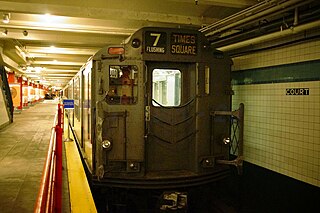
The R12 was a New York City Subway car built by the American Car and Foundry Company in 1948. A total of 100 cars were built, arranged as single units. Two versions were manufactured: Westinghouse (WH)-powered cars and General Electric (GE)-powered cars.

The R21 was a New York City Subway car built by St. Louis Car Company from 1956 to 1957 for the IRT A Division. A total of 250 cars were built, arranged as single units. Two versions were manufactured: Westinghouse (WH)-powered cars and General Electric (GE)-powered cars.

The R33 was a New York City Subway car model that was built by St. Louis Car Company in 1962 and 1963. The cars are a "follow-up" or supplemental stock for the A Division's R29s and closely resemble them. The cars were also referred to as R33MLs to distinguish them from the R33Ss. A total of 500 cars were built, numbered 8806–9305, and arranged in pairs.

The R27 was a New York City Subway car model built by the St. Louis Car Company from 1960 to 1961 for the IND/BMT B Division. A total of 230 cars were built, arranged in married pairs. Two versions were manufactured: Westinghouse (WH)-powered cars and General Electric (GE)-powered cars.

The R30 was a New York City Subway car model built by St. Louis Car Company from 1961 to 1962. The cars were a "follow-up" or supplemental stock for the B Division's R27s and closely resembled them. A total of 320 cars were built, arranged in married pairs. Three versions were manufactured: Westinghouse (WH)-powered cars, General Electric (GE)-powered cars, and R30As.

The R14 was a New York City Subway car model built by the American Car and Foundry Company in 1949. The cars were a "follow-up" or supplemental stock for the A Division's R12s and look exactly the same, differing only in floor patterns. A total of 150 cars were built, arranged as single units. Two versions were manufactured: Westinghouse (WH)-powered cars and General Electric (GE)-powered cars.

The R17 was a New York City Subway car model built by the St. Louis Car Company in 1954 for the IRT A Division. A total of 400 cars were built, arranged as single units. Two versions were manufactured: Westinghouse (WH)-powered cars and General Electric (GE)-powered cars.
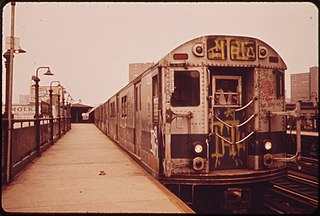
The R22 was a New York City Subway car built by the St. Louis Car Company from 1957 to 1958. The cars were a "follow-up" or supplemental stock for the A Division's R21s and closely resemble them. A total of 450 cars were built, arranged as single units. Two versions were manufactured: Westinghouse (WH)-powered cars and General Electric (GE)-powered cars.

The R26 was a New York City Subway car model built by American Car and Foundry from 1959 to 1960 for the IRT A Division. A total of 110 cars were built, arranged in married pairs.
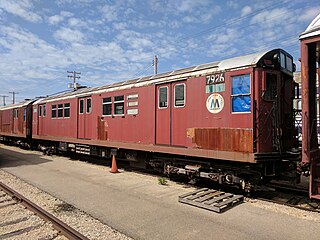
The R28 was a New York City Subway car model built by American Car and Foundry (ACF) from 1960 to 1961. The cars were a "follow-up" or supplemental stock for the A Division's R26s and closely resemble them. The average car cost per R28 was $114,495. A total of 100 cars were built, arranged in married pairs.

The R29 was a New York City Subway car model built by the St. Louis Car Company in 1962 for the IRT A Division. A total of 236 cars were built, arranged in married pairs.

The World's Fair Lo-V was a New York City Subway car type built in 1938 by the St. Louis Car Company in St. Louis, Missouri. These 50 cars were ordered for the IRT Flushing Line in preparation for the 1939 World's Fair. They were the fourth and last "Lo-V" type cars that were ordered, and the last cars ordered for the IRT before the city takeover in 1940.

The Standard Lo-V was a New York City Subway car type built from 1916 to 1925 by the Pressed Steel Car Company, American Car and Foundry, and Pullman Company for the IRT. A total of 1,020 cars were built, which consisted of 725 motors and 295 trailers. It was the third and most common "Lo-V" type car ordered for the IRT.
